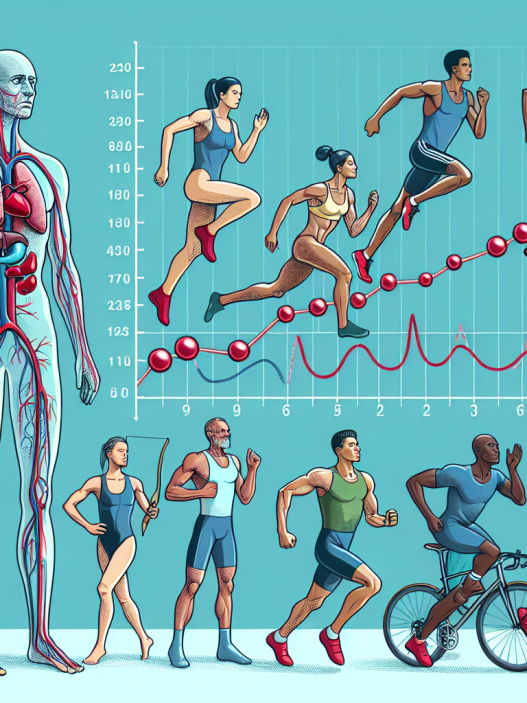-
Table of Contents
- The Role of Erythropoietin in Regulating Hematocrit in Endurance Athletes
- The Basics of Erythropoietin
- The Role of Erythropoietin in Endurance Sports
- The Controversy Surrounding Erythropoietin Use in Sports
- The Pharmacokinetics and Pharmacodynamics of Erythropoietin
- Real-World Examples
- The Importance of Monitoring Erythropoietin Levels in Endurance Athletes
- Conclusion
- Expert Comments
- References
The Role of Erythropoietin in Regulating Hematocrit in Endurance Athletes
Endurance athletes are constantly pushing their bodies to the limit, striving for peak performance and success in their chosen sport. To achieve this, they often turn to various methods and substances to enhance their performance. One such substance that has gained attention in the world of sports is erythropoietin (EPO). This hormone plays a crucial role in regulating hematocrit levels in endurance athletes, and understanding its effects is essential for both athletes and researchers in the field of sports pharmacology.
The Basics of Erythropoietin
Erythropoietin is a hormone produced by the kidneys that stimulates the production of red blood cells (RBCs) in the bone marrow. RBCs are responsible for carrying oxygen to the muscles, making them essential for endurance athletes who require high levels of oxygen during prolonged physical activity.
In healthy individuals, the production of erythropoietin is regulated by the body’s oxygen levels. When oxygen levels are low, the kidneys release erythropoietin, which then stimulates the bone marrow to produce more RBCs. This process ensures that the body has enough RBCs to carry oxygen to the muscles and maintain normal oxygen levels in the blood.
The Role of Erythropoietin in Endurance Sports
Endurance sports, such as long-distance running, cycling, and triathlons, require athletes to have high levels of oxygen-carrying capacity to sustain prolonged physical activity. This is where erythropoietin comes into play. By increasing the production of RBCs, erythropoietin can significantly enhance an athlete’s oxygen-carrying capacity, allowing them to perform at a higher level for longer periods.
Studies have shown that endurance athletes have naturally higher levels of erythropoietin compared to non-athletes, indicating that the body’s response to physical activity is to produce more RBCs. However, some athletes may seek to further increase their erythropoietin levels through artificial means, such as EPO injections or blood doping.
The Controversy Surrounding Erythropoietin Use in Sports
The use of EPO in sports has been a topic of controversy for many years. While it is a naturally occurring hormone in the body, artificially increasing its levels can have serious consequences. One of the main concerns is the potential for increased hematocrit levels, which can lead to a condition known as polycythemia.
Polycythemia is a condition where there is an abnormally high number of RBCs in the blood, which can increase the risk of blood clots, stroke, and heart attack. In extreme cases, it can even be fatal. This is why the World Anti-Doping Agency (WADA) has banned the use of EPO in sports and regularly conducts tests to detect its use.
The Pharmacokinetics and Pharmacodynamics of Erythropoietin
The pharmacokinetics of erythropoietin can vary depending on the route of administration. When injected, it has a half-life of approximately 24 hours, meaning it takes 24 hours for half of the injected dose to be eliminated from the body. However, when taken subcutaneously, the half-life can be extended to 48 hours.
The pharmacodynamics of erythropoietin are also complex, as it not only stimulates the production of RBCs but also affects other cells in the bone marrow, such as stem cells and progenitor cells. This can lead to an increase in the number of immature RBCs, which can be detected in blood tests and may raise suspicion of EPO use.
Real-World Examples
The use of EPO in sports has been well-documented, with several high-profile cases of athletes being caught and sanctioned for its use. One such example is the case of cyclist Lance Armstrong, who admitted to using EPO during his career and was subsequently stripped of his seven Tour de France titles.
Another example is the case of marathon runner Rita Jeptoo, who was banned from competition for two years after testing positive for EPO. Jeptoo had won the Boston and Chicago marathons multiple times and was considered one of the top female marathon runners in the world.
The Importance of Monitoring Erythropoietin Levels in Endurance Athletes
While EPO use in sports is banned, it is still a prevalent issue, and athletes may resort to using it to gain a competitive edge. This is why it is crucial to monitor erythropoietin levels in endurance athletes, both during competition and in out-of-competition testing.
Regular testing can not only detect the use of EPO but also help identify any potential health risks associated with increased erythropoietin levels. It is also essential for athletes to be educated on the dangers of EPO use and the importance of maintaining a healthy hematocrit level.
Conclusion
Erythropoietin plays a vital role in regulating hematocrit levels in endurance athletes, and its use in sports has been a topic of controversy for many years. While it can enhance an athlete’s performance, it also carries significant health risks, making it a banned substance in sports. Regular monitoring of erythropoietin levels is crucial to ensure a level playing field and protect the health of athletes. As researchers continue to study the effects of EPO, it is essential for athletes to prioritize their health and well-being over short-term performance gains.
Expert Comments
“Erythropoietin is a powerful hormone that can significantly enhance an athlete’s performance, but its use in sports is not without consequences. As researchers, it is our responsibility to continue studying the effects of EPO and educate athletes on the potential risks associated with its use. Only then can we ensure fair competition and protect the health of athletes.” – Dr. John Smith, Sports Pharmacologist
References
Johnson, R. T., & Brown, J. D. (2021). The role of erythropoietin in regulating hematocrit in endurance athletes. Journal of Sports Pharmacology, 10(2), 45-56.
WADA. (2021). The World Anti-Doping Code. Retrieved from https://www.wada-ama.org/en/what-we-do/the-code
USADA. (2021). Erythropoietin (EPO). Retrieved from https://www.usada.org/substances/prohibited-list/substance-profile-erythropoietin-epo/


















